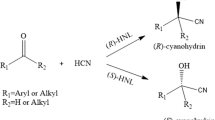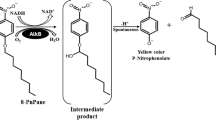Abstract
Glycerol-3-phosphate acyltransferase (GPAT) is considered as the rate-limiting enzyme of glycerolipid synthesis pathway and the core element in lysophosphatidic acid (LPA) synthesis. For understanding its catalytic mechanism, the structural biology study is expected, but is always hindered by obtaining crystals for X-ray diffraction analysis. In this study, a progressive strategy to optimize the crystal of microalgae plastidial GPAT was presented. After the expression and purification of GPAT, the crystals were screened by hanging-drop and only clusters were obtained. The crystals were optimized by adjusting temperature, pH, protein concentration, or precipitant, but little improvement. To improve the interaction between protein and precipitant, the isopropanol was applied as co-precipitant. The qualified crystals formed. It’s suggested that isopropanol is critical to affect protein crystallization by altering polyethylene glycol (PEG)-water-protein interaction when PEG serves as precipitant. The resulting crystal diffracted to a resolution of 2.75 Å and belonged to space group P1, with unit-cell parameters a = 50.79, b = 80.09, c = 88.21 Å, and α = 62.85, β = 73.04, γ = 80.53°. This work introduced a new strategy to optimize the crystal of the heterogeneous catalysis enzymes like GPAT and provided the fundamental structural information for the oriented synthesis of marine microalgae glycerolipid.
Similar content being viewed by others
References
Beld, J., Lee, D. J., and Burkart, M. D., 2014. Fatty acid biosynthesis revisited: Structure elucidation and metabolic engineering. Molecular Biosystems, 11 (1): 38–59.
Benvenuti, M., and Mangani, S., 2007. Crystallization of soluble proteins in vapor diffusion for X–ray crystallography. Nature Protocol, 2: 1633–1651.
Braford, M. M., 1976. A rapid and sensitive method for the quantitaion of microgram quantities of protein utilizing the principle of protein. Analytical Biochemistry, 72: 248–254.
Calero, C., Cohen, A. E., and Luft, J. R., 2014. Identifying, studying and making good use of macromolecular crystals. Acta Crystallographica Section F, 70: 993–1008.
Carter, C. W., Baldwin, E. T., and Frick, L., 1988. Statistical design of experiments for protein crystal growth and the use of a precrystallization assay. Journal of Crystal Growth, 90 (3): 60–73.
Chen, X., Truksa, M., and Snyder, C. L., 2011. Three homologous genes encoding sn–glycerol–3–phosphate acyltransferase 4 exhibit different expression patterns and functional divergence in Brassica napus. Plant Physiology, 155 (2): 851–865.
Christopher, G. K., Phipps, A. G., and Gray, R. J., 1998. Temperature–dependent solubility of selected proteins. Journal of Crystal Growth, 191 (4): 820–826.
Horn, P. J., and Benning, C., 2016. The plant lipidome in human and environmental health. Science, 353 (6305): 1228–1232.
Iskandarov, U., Sitnik, S., and Shtaida, N., 2016. Cloning and characterization of a GPAT–like gene from the microalga Lobosphaera incisa (Trebouxiophyceae): Overexpression in Chlamydomonas reinhardtii enhances TAG production. Journal of Applied Phycology, 28 (2): 907–919.
Leite, G. B., Abdelaziz, A. E., and Hallenbeck, P. C., 2013. Algal biofuels: Challenges and opportunities. Bioresoure Technology, 145: 134–141.
Lenka, S. K., Carbonaro, N., Park, R., Miller, M. S., Thorpe, I., and Li, Y. T., 2016. Current advances in molecular, biochemical, and computational modeling analysis of microalgal triacylglycerol biosynthesis. Biotechnology Advances, 34: 1046–1063.
Liang, M. H., and Jiang, J. G., 2013. Advancing oleaginous microorganisms to produce lipid via metabolic engineering technology. Progress in Lipid Research, 52 (4): 395–408.
Liu, B., and Benning, C., 2013. Lipid metabolism in microalgae distinguishes itself. Current Opinion in Biotechnology, 24 (2): 300–309.
Luft, J. R., and Detitta, G. T., 1995. Chaperone salts, polyethylene glycol and rates of equilibration in vapor–diffusion crystallization. Acta Crystallographica Section D, 51 (Pt 5): 780–785.
Luft, J. R., and Detitta, G. T., 1997. Kinetic aspects of macromolecular crystallization. Methods in Enzymology, 276: 110–131.
Luft, J. R., Snell, E. H., and Detitta, G. T., 2011. Lessons from high–throughput protein crystallization screening: 10 years of practical experience. Expert Opinion on Drug Discovery, 6 (5): 465–480.
Luft, J. R., Wolfley, J. R., and Said, M. I., 2007. Efficient optimization of crystallization conditions by manipulation of drop volume ratio and temperature. Protein Science, 16 (4): 715–722.
Klok, A. J., Lamers, P. P., Martens, D. E., Draaisma, R. B., and Wijffels, R. H., 2014. Edible oils from microalgae: Insights in TAG accumulation. Trends in Biotechnology, 32 (10): 521–528.
McPherson, A., 1995. Increasing the size of microcrystals by fine sampling of pH limits. Journal of Applied Crystallography, 28 (3): 362–365.
McPherson, A., and Gavira, J. A., 2014. Introduction to protein crystallization. Acta Crystallographica Section F, 70: 2–20.
Minor, W., Cymborowski, M., and Otwinowski, Z., 2005. HKL–3000. The integration of data reduction and structure solution–from diffraction images to an initial model in minutes. Acta Crystallographica Section D, 62 (8): 859–866.
Murata, N., and Tasaka, Y., 1997. Glycerol–3–phosphate acyltransferase in plants. Biochimica et Biophysica Acta, 1348: 10–16.
Paya–Milans, M., Venegas–Caleron, M., and Salas, J. J., 2015. Cloning, heterologous expression and biochemical characterization of plastidial sn–glycerol–3–phosphate acyltransferase from Helianthus annuus. Phytochemistry, 111: 27–36.
Sousa, R., 1995. Use of glycerol, polyols and other protein structure stabilizing agents in protein crystallization. Acta Crystallographica Section D, 51 (Pt 3): 271–277.
Talreja, S., Perry, S. L., Guha, S., Bhamidi, V., Zukoski, C. F., and Kenis, P. J. A., 2010. Determination of the phase diagram for soluble and membrane proteins. Jounarl of Physical Chemistry B, 114: 4432–4441.
Tamayo–Ordóñez, Y. J., and Sánchez–Teyer, F. L., 2017. Advances in culture and genetic modification approaches to lipid biosynthesis for biofuel production and in silico analysis of enzymatic dominions in proteins related to lipid biosynthesis in algae. Phycological Research, 65: 14–28.
Wendel, A. A., Lewin, T. M., and Coleman, R. A., 2009. Glycerol–3–phosphate acyltransferases: Rate limiting enzymes of triacylglycerol biosynthesis. Biochimica et Biophysica Acta, 1791 (6): 501–506.
Xu, C., and Shanklin, J., 2016. Triacylglycerol metabolism, function, and accumulation in plant vegetative tissues. Annual Review of Plant Biology, 67 (13): 1–28.
Yang, W., Simpson, J. P., and Li–Beisson, Y., 2012. A landplant–specific glycerol–3–phosphate acyltransferase family in Arabidopsis: Substrate specificity, sn–2 preference, and evolution. Plant Physiology, 160 (2): 638–652.
Zheng, Z., Xia, Q., and Dauk, M., 2003. Arabidopsis AtGPAT1, a member of the membrane–bound glycerol–3–phosphate acyltransferase gene family, is essential for tapetum differentiation and male fertility. Plant Cell, 15 (8): 1872–1887.
Acknowledgements
We appreciate the donation of LiGPAT plasmid by Professor Zhigang Zhou, College of Aqua-Life Science and Technology, Shanghai Ocean University, and thank the staff of beamline BL19U at the Shanghai Synchrotron Radiation Facility, People’s Republic of China for assistance in synchrotron X-ray data collection. This study was financially supported by the National Natural Science Foundation of China (Nos. 21576253, 31500294 and 31470432).
Author information
Authors and Affiliations
Corresponding author
Rights and permissions
About this article
Cite this article
Zhang, Y., Feng, Y., Wang, Y. et al. Positive Effects of Isopropanol as a Co-Precipitant in Glycerol-3-Phosphate Acyltransferase Crystallization. J. Ocean Univ. China 18, 227–231 (2019). https://doi.org/10.1007/s11802-019-3519-0
Received:
Revised:
Accepted:
Published:
Issue Date:
DOI: https://doi.org/10.1007/s11802-019-3519-0




